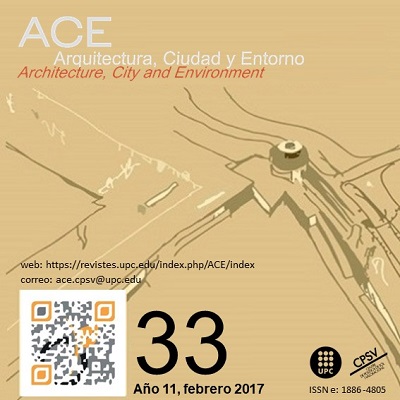Tecnologies de la Informació: amenaces i oportunitats per a la transformació de la ciutat contemporània
DOI:
https://doi.org/10.5821/ace.11.33.4850Paraules clau:
Transformacions urbanes, participació ciutadana, societat de la informacióResum
En una etapa de profundes i molt ràpides transformacions de la societat és important entendre els efectes que aquestes poden tenir sobre l'entorn construït que ens envolta. Les transformacions de principi del segle XX que van portar a la definició d'una societat pròpiament moderna poden servir per comprendre les que estan configurant l'esdevenir del segle XXI. Reconeguda la importància dels fluxos en la configuració de la ciutat contemporània, i el paper de determinades empreses tecnològiques pel seu impacte en els mitjans i en les economies de diferent escala, s'evidencien els seus possibles efectes sobre la ciutat.
A més de les transformacions físiques, s'intueix la possibilitat que es produeixin diferents solucions per a les nostres necessitats, personalitzades en funció de la informació que les empreses coneixen dels nostres hàbits. És per tant fàcil d'imaginar com cada ciutadà pugui viure en una món fragmentat i tangent al de les persones que es troben al seu voltant, tot i que aquesta mateixa tecnologia ofereix oportunitats de transformació participatives.
Malgrat existir nombrosos estudis sobre empreses tecnològiques que estan impulsant aquestes innovacions i sobre els efectes de les transformacions socials en la ciutat, aquest estudi planteja els possibles efectes sobre la configuració de la ciutat del futur, reconeixent l'impacte cada vegada més gran de les connexions sobre el desenvolupament urbà. El seu hipotètic compliment ha de ser un avís per als responsable de la planificació urbana per tenir en compte aquestes tendències, valorar els possibles amenaces, i aprofitar les oportunitats que s'obren per a un millor gaudi i inclusió social en el context urbà.
Descàrregues
Publicades
Número
Secció
Llicència
| CRITERIS DE PROTECCIÓ INTEL·LECTUAL |
En aquest moment es compta amb la protecció de la Oficina Espanyola de Patents i Marques, mentre que la protecció global s'està tramitant davant la Organització Mundial de la Propietat Intel·lectual (OMPI/WIPO). Així mateix, la Oficina del Número de Sèrie Estàndar Internacional (ISSN) ha otorgat els següents números: 1886-4805 (versió electrònica) i 1887-7052 (versió en paper). |
| COPYRIGHT |
El contingut dels articles i els comentaris en ells expresats són responsabilitat exclusiva dels seus actors, i no reflexen necessariament la opinió del Comité Editor de la revista. Els treballs publicats per ACE queden sotmesos a la llicència CC BY-NC-ND 3.0 ES http://creativecommons.org/licenses/by-nc-nd/3.0/es/ La qual cosa vol dir que les persones autores només tenen i retenen els drets d'autor dintre de les limitacions imposades per la anterior llicència |





































